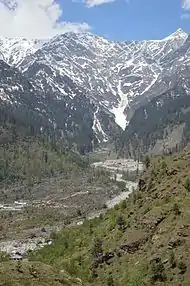Kullu Valley
Kullu Valley is a broad open valley in Himachal Pradesh, India, formed by the Beas River between Manali and Largi.[1] This valley is famous for its temples, beauty and its majestic hills covered with pine and deodar forest and sprawling apple orchards. The course of the Beas river presents a succession of magnificent, clad with forests of deodar, towering above trees of pine on the lower rocky ridges. Kullu valley is sandwiched between the Pir Panjal, Lower Himalayan and Great Himalayan Ranges.[2] Ski touring is a sport growing in popularity in the Himilayan peaks surrounding the valley[3]
| Kullu Valley | |
|---|---|
| Kulu Valley | |
 Kullu Valley with River Beas | |
| Geology | |
| Type | River Valley |
| Geography | |
| Location | Himachal Pradesh in India |
| Population centers | Kullu |
| Coordinates | 31°57′28″N 77°6′34″E |
| Rivers | Beas River |
Kullu or Kulu, the capital town of the Kullu district in the Indian state of Himachal Pradesh is located in this valley. This valley is 75 kilometre in length and about 2 to 4 km in width and ends near the famous Rohtang pass. Naggar Castle, Nehru Kund, Roerich Art Gallery, Hidimba Temple are main attractions of this valley.
Gallery

 Himalayas from the Kullu Valley
Himalayas from the Kullu Valley Autumn in Kullu Valley
Autumn in Kullu Valley View of Himalayas from Beas river valley in Kullu
View of Himalayas from Beas river valley in Kullu
References
- CIL. "Exhibition - Malana - A Lost Utopia in the Himalayas". ignca.nic.in. Archived from the original on 3 March 2016. Retrieved 20 September 2017.
- PRADESH, HIMACHAL. "Mythological references and evidances - Kullu District Official Website, Himachal Pradesh". himachal.gov.in. Retrieved 20 September 2017.
- Spooner, Campbell (2002). Ski Touring India's Kullu Valley. Canada: Alpine Touring Publishing. p. 160. ISBN 0958108609.